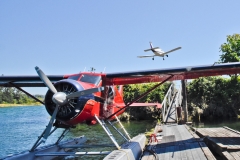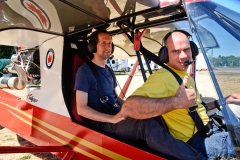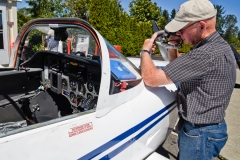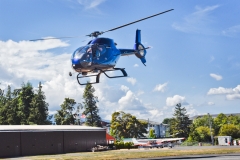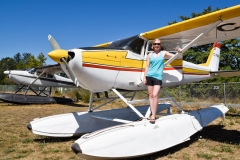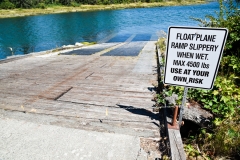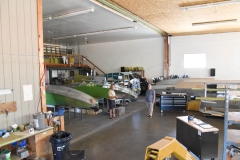
by George Le Masurier | Aug 7, 2018
The Courtenay Airpark Association believes the city is trying to close down this unique facility on the Vancouver Island coast. In a presentation to City Council today, Airpark volunteers will detail its economic, social and lifestyle benefits for the community
Editor’s note: this story was updated at 9 a.m. to include a Medivac helicopter landing at the Airpark last night due to unfavorable conditions at the hospital heli-pad.
Fearing that someone at Courtenay City Hall wants to turn the Airpark into a condo development, pilots and aviation business owners will pitch the facility’s economic benefits at 4 p.m. today (Aug. 7) to the City Council.
Closing the Courtenay Airpark would shutter several aviation businesses and put roughly 50 people out of work, not to mention the estimated indirect loss of more than $20 million in spin-off economic activity, social benefits and the displacing of 72 private aircraft to other Island communities.
So who is trying to close the Airpark?
Mo Perry, president of the Courtenay Airpark Association, isn’t sure. But he says the signals started well before city staff released a proposed update to its transportation plan that shows a new bridge going directly through the Airpark.
The city, which owns the Airpark land, has been converting leases for aviation businesses, hangars and the volunteer association that runs the aerodrome from a five-year term to month-to-month.
“No business can operate on month-to-month leases successfully,” Perry says. “The uncertainty stifles investment and growth.”
Al Pheaton’s International Aeroproducts Inc. employs 15 tradesmen and up to 30 during the busy winter months fabricating floats for seaplanes and during major restorations of Beaver and Otter aircraft. It’s known worldwide in the aviation community as one of the best in the business.
Pheaton’s business is so successful that he needs to expand his floorspace either into a second, separate building or by adding on to the existing one. But he can’t get approval from the City of Courtenay.
“And anyway, what bank is going to loan money to a business for expansion on a month-to-month lease,” Perry said.
FURTHER READING: Battle brewing over transportation plan; City bridge proposal would harm Airpark, Kus-kus-sum
The Courtenay Airpark is unique in British Columbia because it is accessible for both wheel and float planes. Pilots can bring their floatplanes in for repair and leave via wheeled planes.
But the city has been stalling a long, overdue restoration of the float plane ramp, despite provincial and federal support and approval for the project.
So when the proposed transportation plan update came out with a road and bridge through the Airpark’s runway, Perry said the city’s plan became obvious.
But Airpark volunteers don’t know who at city hall is trying to drive them out.
Current Mayor Larry Jangula and the three mayoralty candidates — David Frisch, Erik Eriksson and Bob Wells — have all previously told Decafnation that Airpark volunteers and business owners shouldn’t worry about the proposed third crossing at 21st Street.
“It’s just a concept,” Jangula said.
Decafnation emails Jangula and the three mayoralty candidates yesterday (Aug. 6) and asked if they were in favor of closing the Courtenay Airpark and using the land for some other purpose:
Eriksson said, “I like the Airpark.”
Frisch said, “That question has too many unknowns to give a yes or no answer. I do value the airpark amenity, but I must stay open to all possibilities for this city owned asset.”
Wells and Jangula did not reply.
Other organizations, like Project Watershed, are also alarmed by the 21st Street bridge proposal. A roadway and bridge there would slice Hollyhock Marsh in half and affect the group’s future restoration of the old Field’s Sawmill site, known now as Kus-kus-sum. The group has said it would oppose any crossing south of 17th Street.
Comox Valley Nature President Jim Boulter has said his organization is also opposed to the 21st Street bridge proposal.
Hollyhock Marsh is provincially owned and protected land, so it’s somewhat unlikely the city would be allowed to build a bridge through it.
But Perry and other Airpark volunteers, like Dave Mellin, worry that abandoning the bridge proposal won’t diminish the city’s attacks on the Airpark despite its 2016 Official Community Plan that requires council to “protect the integrity of the airpark and marina facilities at 20th Street; work with non-profit societies to improve and expand facilities as required.”
“The Airpark is the only park owned by the city that actually generates revenue,” Perry said. “All of their other parks cost the city money.”
WHAT’S AT STAKE
The Airpark was originally built by local pilots in the early 1960s. Eric Franklin was the first pilot to land there — on a gravel runway — in September of 1964.
Since its origin 55 years ago, all the improvements to the facility — except for provincial grants for paving the runway and installing an underground fuel system — have been funded from Airpark revenue or through volunteers.
Airpark businesses that include aircraft maintenance, flight schools and timber cruising have created up to 50 direct jobs and roughly 90 indirect jobs, producing about $50,000 in revenue annually for the city.
More than 700 student pilots and in excess of 200 air force cadets have completed their training at the Airpark. There are two Ministry of Transport approved flight schools on site.
The RCMP use the Airpark regularly, and it will continue to be used for patient transfers on Medivac flights because certain weather conditions will impede landing at the new hospital. A Medivac helicopter landed at the Airpark at 6 p.m. last night (aug. 6) because conditions at the hospital helipad were unfavorable.
“Can’t imagine landing on that hospital heli-pad on a typical Comox Valley blistery winter day with a loaded chopper,” Perry said.
In the event of an emergency, such as an earthquake, the Airpark is the only facility on the west side of the river for evacuation or medical transportation if bridges and roads are disabled.
CFB Comox 4 Construction Engineering Squadron does annual testing of the Airpark runway to ensure that it’s safe for certain military air operations if needed, such as Buffalo and helicopters.
WHO USES THE AIRPARK
Andreas Ruttkiewicz, a former military jet pilot, runs the Air Speed High Ultralight flight school. He started his business in 2007 in Victoria and moved it to Comox in 2011. He trains about 12 to 15 pilots a year.
Sealand Flight, a pilot training and aircraft rental company based in Campbell River, plans to open a Courtenay operation this month. It trains pilots for recreational, private and commercial certification.
International Aeroproducts Inc. is currently doing a complete restoration of a classic Beaver float plane and building sets of floats for several others, including a customer from Panama.
A Texada grocery store flies a Cessna 172 into the Courtenay Airpark three times every week to purchase products for resale to island residents. It’s less expensive and quicker than resupplying via ferry and ground transportation.
Land surveyor Dave Bazett houses two aircraft at the Airpark, one is an iconic de Havilland Beaver float plane that he uses in his work up and down the coast.
Mike Hamilton houses a helicopter at the Airpark used in his logging business, an operation he wants to expand.
On a tour Aug. 4 of the Airpark, Decafnation met several fliers.
Courtenay resident Karina Bakker (also A Mt. Washington ski patrol) just purchased a Cessna 172 on floats in Manitoba and flew it back to the Airpark. She was recently employed by Coril Air doing charter flights out of Campbell River.
“On the coast, there’s no freedom like flying with floats,” she said.
George and Cheryl T. (who asked to keep their last name private) flew in from Abbotsford on a Eurocopter EC120 helicopter with their two daughters to meet up with friends for a cruise on their catamaran sailboat.
Cheryl, who used to live in the Comox Valley, is also a pilot and has flown in and out of the Airpark often.
“This is a classic airport of the type we need to protect,” she said.

by George Le Masurier | Jul 23, 2018
The City of Courtenay may recommend a third bridge as part of its 2018 transportation master plan, but Project Watershed will oppose any crossing of the Courtenay River south of 17th Street
A battle is brewing over how to improve the flow of traffic through Courtenay and across the Courtenay River without destroying established businesses and key portions of the K’omoks estuary.
The fight could pit the city against Project Watershed, K’omoks First Nations, business owners at the Courtenay Airpark and others over a proposed third crossing at 21st St., which would close the airpark, destroy portions of the estuary and have devastating effects on the Kus-kus-sum restoration.
The city is developing a much-needed transportation master plan that will guide City Councils over the next 20 years on where to invest in new infrastructure and how to meet the transportation needs of a growing population.
The plan is long overdue, and the failure of the city to develop such a plan in the past has limited the city’s options today to meet future transportation requirements.
Mayor Larry Jangula and some council members have downplayed a consultant’s report that recommends the 21st St. crossing as simply “a concept.” But Project Watershed and airpark business owners worry that a ho-hum attitude could result in the “concept” being enshrined in the master plan.
In a strong letter to the mayor and council, Project Watershed has said it will oppose any third crossing of the Courtenay River south of 17th St.
“This route, which would go through wetlands, across agricultural lands and creeks in order to hook up with Comox Road and then eventually Macdonald Road, is ill advised in the extreme,” wrote Project Watershed Chair Paul Horgen.
“The permanent damage that would be done to sensitive ecological areas, including Hollyhock Marsh, Glen Urquhart and Mallard Creeks, as well as Dike Slough by such a project, is unacceptable. This additional crossing would also affect those that enjoy the recreational opportunities afforded by the Courtenay Airpark Lagoon trails, Horgen said in his letter.
Horgen said the city should appreciate the sensitive habitat values of the area and the importance of conserving key eco-assets.
The city is a full partner with the nonprofit and K’omoks First Nation in the restoration of the old Fields Sawmill site, known as Kus-kus-sum.
In response, Mayor Jangula seemed to indicate there was no cause for alarm.
“I understand your concerns. This was simply a report on transportation plans with suggestions on where to place a third crossing,” Jangula wrote. “The City has no plans at this time to build another bridge. The idea is conceptual.”
That provided little comfort for Project Watershed.
“Thanks for your early response Mayor Jangula. Our deep concern is that this non-viable and ill-informed Option B crossing, being a conceptual report or not, will continue to persist in future planning documents, as these things have been shown to do in the past,” Horgen responded. “Our preference would be to see it removed entirely from this process.”
How was the recommendations developed?
According to a fact sheet published by city staff, the City has explored several alternative crossings of the Courtenay River beyond the 5th Street and 17th Street bridges since 2005.
Public feedback has indicated that growth pressures on the crossings, downtown and northeast areas, as well specifically Ryan Road and Highway 19A Bypass were areas of concern.
But most of the city’s options for a third crossing have been eliminated by a “combination of previous decisions and studies along with technical review in 2018 … due to impacts and/or changes to localized conditions (including 3rd Street, 6th Street, 8th Street, 11th Street, 13th Street, 19th Street, and 20th Street).”

That left crossing alternatives at 21st Street and 29th Street, but “preliminary investigations and stakeholder meetings resulted in eliminating 29th Street from further review largely based on the reduced traffic diversion that would be expected, as well as the significant costs and high environmental impacts.”
That last statement is ironic according to Project Watershed Technical Director Dan Bowen.
“Project Watershed has worked hard to secure the old sawmill site to restore the shoreline of the Courtenay River. The option B flies in the face of all the city’s support of the Kus Kus Sum,” Bowen has said. “The wetland salt marsh ecosystem must be kept as a unit for connectivity of plant species and fish channels.”
Morris Perry, a spokesperson for the Courtenay Airpark, says the community benefits from the facility and supports it. He points to a May 2015 poll by the Comox Valley Record in which 93.7 percent of respondents said the Airpark should stay.
“Lots of votes here and, yes, lots of retired air force families that love the airpark and the green space it provides,” Perry wrote in a comment on Decafnation. “Oh yes, and no cost to the taxpayer as its 100 percent maintained by volunteers and of course all the jobs it provides working on aircraft from companies all over North America, not just Harbour Air.”
What’s next
Courtenay city staff will present final recommendations for the transportation master plan in the fall. The current council will consider the plan, including any changes they want before final adoption.
However, future council members will decide to proceed with specific recommendations in the plan and fund them through the annual budgeting process.
FURTHER READING: City bridge proposal would harm airpark, Kus-kus-sum; Project Watershed, K’omoks First Nations to restore sawmill site

by George Le Masurier | Jul 18, 2018
CVRD directors overlook their Regional Growth Strategy to expedite an application by 3L Developments to amend the RGS that would enable a 740-house project on the Browns and Puntlege rivers near Stotan Falls
BREAKING: In another surprising twist to the 3L Developments proposal for Stotan Falls, the July 17 Committee of the Whole vote that defeated a motion to consider the issue via the minor amendment process has been overturned. The motion has now passed on a 5-3 simple majority, and it will be recommended to the entire Comox Valley Regional District board later this month that the 3L application for an amendment to the Regional Growth Strategy be considered by the minor amendment process. When the full board votes, however, a two-thirds majority will be required.
Here is a statement from the CVRD legislative services team:
“In preparing the minutes for yesterday’s (July 17) Committee of the Whole meeting, Regional District staff considered the issue of whether the Committee’s vote on the process for proceeding with the amendment to the RGS proposed by 3L Development required a two-thirds majority or a simple majority vote for the Committee to recommend to the Board that it proceed as a minor amendment. Having reviewed the Regional District’s Procedure Bylaw, the RGS, and the applicable statutes, staff are of the view that there is an arguable issue as to the required vote. In the circumstances, and as the RGS makes clear that the determination of whether an amendment is a minor amendment must be made by the Board, staff have concluded that it is fair and reasonable to resolve the issue in favour of the applicant and have prepared the Minutes to reflect that the motion to proceed with the amendment as a minor amendment was carried on a simple majority vote of 5 to 3. By doing so, the matter will properly be on the agenda for the upcoming Board meeting and the Board will be in a position to fulfill its duty to determine, if the amendment is initiated, on a two-thirds majority basis whether the amendment will proceed as a minor amendment or, in default, as a standard amendment”
—
The original story follows …
Editor’s note: this article was amended July 23 to provide context for a quote by David Dutcyvich
For Comox Valley Regional District directors Bob Wells and Rod Nichol, expediency justifies circumventing a requirement of the board’s own Regional Growth Strategy.
Wells and Nichol were two of five directors to vote July 17 in favor of considering a proposal by 3L Developments to change the RGS as a minor amendment, rather than through the standard amendment process.
The two directors joined Larry Jangula, Ken Grant and Bruce Jolliffe to support a motion to proceed via the minor amendment process.
Erik Eriksson, Curtis Scoville and Barbara Price voted against the motion.
It was the second time for directors to vote on the issue. On July 10, they defeated the motion with only Grant and Jangula supporting it.
But the board had voted at that time after hearing incorrect information that a future unanimous vote in the minor amendment process would be required for the proposal to pass first reading. In fact, only a majority vote would be required at first reading.
So when the board’s Committee of the Whole reconvened a week later, on July 17, and voted again after discussing the corrected information and another hour of debate on the matter.
What’s surprising about the vote is that the CVRD’s Regional Growth Strategy clearly states the criteria that a proposed amendment must meet in order to be considered through the minor amendment process.
Area B Director Nichol asked CVRD staff to display section 5.2.3(a) of the RGS, which refers to the “criteria under which a proposed amendment to the RGS may be considered a minor amendment:”
It can be minor, if it is not regionally significant, contributes to the goals and objectives of the RGS, contributes to achieving the general principles in the RGS, and is not directly related to enabling a specific proposed development.
Nichol then went through each criterion and explained why, in his opinion, the 3L proposal did not meet any of them. But he voted in favor anyway.
Wells expressed similar difficulty with the criteria.
After the meeting Wells told Decafnation that he voted in favor of the minor amendment process anyway because he was satisfied the board “could still get a fulsome and meaningful” review of the 3L proposal “equivalent to the standard amendment” process.
Wells said his concern was the timeline for responses from other governments required under the standard amendment process, which “from my experience can be significant, and it seemed very unclear there would be any benefit.”
Nichol said the board has “inherited an issue that should have been decided a long time ago.”
“Yes, it did not meet all the requirements, but I firmly believe we can come up with a decision that conforms with the wishes of the people.”
Director Eriksson, who opposed the minor amendment process, said the 3L Developments proposal for 740 houses at Stotan Falls is a significant change to the Regional Growth Strategy.
“I’ve been critical of the RGS in the past,” he said. “But it reflects the aspirations of the public.”
The mayors of each municipality and the electoral area directors signed a protocol on “managing growth in the Comox Valley” in September of 2006. That lead to the development of the RGS, which was adopted in March 2011.
The Regional Growth Strategy is the culmination of considerable public input, negotiation among elected officials and feedback from local government staff through the board’s Technical Advisory and Steering committees.
But five directors, including Wells and Nichol, ignored that work for the sake of moving along consideration of the 3L Developments proposal a little bit quicker.
And 3L Developments has been trying to get CVRD approval for a long time.
It has been 11 years since 3L Development founder Dave Dutcyvich originally proposed to build a self-contained riverfront community on 550 acres between the Browns and Puntledge rivers, north of Courtenay.
His company has offered to donate 260 acres for a public park that includes access to the popular swimming area known as Stotan Falls.
3L spokesman Kabel Atwall said they have grown weary of the delays that have prevented them from going ahead with their project. Atwall said consulting other regional districts, as a standard amendment process requires, could “spin the whole process out of control.”
Dutcyvich also spoke to the board prior to its vote on July 17.
“There’s a lot of money tied up (in the project), and it has to come to an end some time,” he said. “To quote the mayor of Ottawa, ‘I don’t want the red tape, I want the red carpet’.”

by George Le Masurier | Jul 17, 2018
Ministry officials explain and justify their Sackville Road groundwater extraction decision, saying no negative effects will result. But Merville residents question the ministry’s data and remain suspicious about negative effects on their wells
EDITOR’s NOTE: This story was updated at 11 a.m. July 17
Provincial government officials who reviewed and approved a groundwater extraction license for a proposed Sackville Road water bottling operation explained their decision-making process to a packed house at the Merville Community Hall last night (July 16).
Representatives of the Nanaimo Branch of the Ministry of Forests, Lands, Natural Resource Operations and Rural Development (FLNRORD) used a PowerPoint presentation to convince the crowd of several hundred people that the extraction of up to 10,000 litres per day from their aquifer won’t result in any negative effects.
The crowd wasn’t buying it.
The audience listened to the presentations with few interruptions and applauded politely for each speaker.
But when the question and answer period began, the mood turned raucous, with catcalls and loud and long cheering for citizens who pressed the ministry officials to defend what was called a “ridiculous” decision.
The ministry issued a groundwater license to Christopher Scott Mackenzie and Regula Heynck, who hope to create a commercial business by selling up to 3.65 million litres of water annually.
The Comox Valley Regional District has not approved the couple’s rezoning application, which is necessary to allow such an operation on the property.
Citizens questioned whether the ministry actually has reliable data about aquifer #408, because the studies it has relied on are 18 years old, and since then accelerated population growth and climate change have altered the facts.
Other citizens called most of the presentation irrelevant because it referred to the effects of the Sackville groundwater extraction on nearby drilled wells. But according to residents, 90 percent of the wells in the area are not drilled, but shallow.
Area C CVRD Director Edwin Grieve, MLA Ronna-Rae Leonard and the Sackville applicants attended the presentation.
How the decision was made
Pat Lapcevic, water protection section head for the ministry’s west coast region, talked through the science behind the extraction approval.
She showed charts of the ministry’s simulations that estimate that current groundwater use in the Merville aquifer is less than 20 percent of its annual recharge, which has been stable over the last 15 years based on data from an observation well located 12 km from the Sackville site.
The aquifer is recharged — a fresh input of water — by precipitation falling on the area and by snowmelt from the Beaufort Mountains.
She said the annual recharge is 34 million metres-cubed, or 34 trillion litres. The current use is estimated at six million metres-cubed, or 18 percent.
Lapcevic said pumping out 10,000 litres per day is “expected” to drawdown water levels in the aquifer by less than three centimetres. It represents less than one percent of the annual recharge.
Daryl Slater, a resource manager in FLNRORD’s Nanaimo office, reminded the audience that his ministry does not make policy, it only implements and monitors policy made by the Ministry of Environment and the BC Legislature.
Ticking off the considerations in reviewing a groundwater license application, Slater said the ministry could find no reason to deny it. They found no negative effects on anyone’s rights or to the wells of nearby users.
Slater said his office consulted with Island Health, local governments, the Ministry of Highways, the Department of Fisheries and Oceans and archeology experts.
He said they also consulted with K’omoks First Nations, but would not reveal the content of those consultations, which he called confidential.
But K’omoks First Nations has publicly opposed the water bottling operation and the issuing of a water license, and told the FLNRORD ministry so in 2017 during the consultation process.
In a strong letter to the CVRD, KFN Chief Nicole Rempel explained their opposition.
Citizens wondered what was the point of ministry consultations if both the Comox Valley Regional District and K’omoks First Nation opposed granting a water license, and the ministry approved it anyway.
Citizens contradict FLNRORD
Bunky Hall, whose shallow well is the closest to the Sackville site, challenged ministry “estimations” of the effect of drilled wells on shallow wells.
He said when the Portuguese Creek Restoration Society drilled a well to keep the stream from going dry during the summer, his 16-foot deep shallow well went dry two days later.
When a water delivery service brought him water, they asked what was going on because they had never delivered water to that area before and all of a sudden they were getting multiple requests.
Ministry officials dismissed his experience saying there probably wasn’t any connection between the two events.
Lapcevic responded that shallow wells were sensitive to climate change and maybe it wasn’t the drilled, pumping well that caused his well to go dry.
“Most of what the ministry people presented tonight is irrelevant,” Hall told Decafnation after the meeting. “About 90 percent of the wells in the vicinity (of Sackville Road) are shallow wells. They only talked about the effects on drilled wells.”
The Technical Report summarty states that “the well (WTN 111987) is on the applicant’s property and is flowing artesian at roughly 15 gpm so a pump is not required at this time.”
Neither Slater or Lapcevic explained that if a pump is unnecessary how the aquifer could be confined and not affect shallow wells.
Bruce Gibbons, a member of the Merville Water Guardians and lives on ALR land about 300 metres from the Sackville Road site, said the ministry presented more detailed information than was contained in their original Technical Report.
“It appears they did significant work after the decision was made and after the opposition to their decision arose,” he told Decafnation.
Gibbons was privy to the original Technical Report because he filed an appeal to the FLNRORD decision. The ministry has not revealed the report to anyone else.
Even MLA Ronna-Rae Leonard was unable to get a copy of the original report.
And the ministry has still not responded to a Freedom of Information request for the report filed in March by Merville Organics farmer Arzeena Hamir.
Slater told the audience he didn’t know why the FOI request hadn’t been fulfilled. He said it’s “unfortunate” it takes so long.
Another speaker challenged the ministry’s assumptions about the stability of the aquifer.
She said the climate change is causing the Comox Glacier and other nearby glaciers to melt, which could be artificially inflating the aquifer’s recharge rate and its stability.
Lapcevic said the ministry is not seeing changes so far due to climate change, but the Sackville Road decision was based on the best data at the time.
Wayne Bradley recognized the FLNRORD ministry was bound by legislation in its decision-making process, so he called on MLA Leonard to champion a political movement to amend the Water Sustainability Act.
“We need to recognize that water is a common property,” he said. “Private profit on a sale of community property is not a beneficial use.”
Leonard left the meeting without responding to Bradley, but made a statement earlier that residents “should feel assured that I have posed these questions also.”
She said the Water Sustainability Act is new, and it’s moving water rights issues in the right direction.
“It takes time,” she said. “Be active, make your concerns known.”
FURTHER READING: Water bottling project raises aquifer concerns; Ministry stalls FOI request on Merville water bottling; “Unbelievable accusations” move water bottling to public hearing

by George Le Masurier | Jul 15, 2018
CVRD directors will vote again — this time with corrected information on their Regional Growth Strategy minor amendment process — on whether to consider 3L Developments application to amend the RGS as a minor or standard matter. It’s not as confusing as it sounds
When the Comox Valley Regional District voted last week to defeat a motion to consider an amendment proposed by 3L Developments to the Regional Growth Strategy as a “minor” process, it was acting on incorrect information.
The correct information will be presented to the CVRD’s Committee of the Whole (COW) at 4 p.m.Tuesday, July 17, and the directors will vote again on whether the 3L application should be considered a “minor” amendment.
The COW was told at its July 10 meeting that a unanimous vote was required to pass first reading of a minor amendment bylaw. And, if the vote wasn’t unanimous, then the proposed amendment would automatically proceed by the standard process.
The standard process requires more robust consultation with stakeholders and neighboring governments and therefore takes longer. A minor amendment process is streamlined without any required consultations. The board could even decide not to hold a public hearing.
But staff discovered after last week’s vote that a unanimous vote is not required.
FURTHER READING: CAO’s memo to the directors
“While section 437(3) of the Local Government Act [RSBC, c. 1, 2015] does describe such a scenario (unanimous vote), the legislation also defers to the process contained in an RGS where the minor amendment process is defined,” wrote Chief Administrative Officer Russell Dyson in a memo to the board.
“The Comox Valley RGS in fact defines a minor amendment process and requires that voting on such amendment bylaws would follow normal procedures (meaning a simple majority on first reading is required for approval).” Dyson said.
See minor vs major comparison chart below
The regional district is taking extra care to be precise in its procedures and voting while considering the 3L Developments application. The company has been vocal and litigious in its criticism of the CVRD’s handling of their applications.
3L Developments sued the regional district in 2015 and won an order by the BC Supreme Court, which was later upheld by an appeals court, that the CVRD should have initiated a process to consider an amendment to the RGS, and was directed to do so.
The Committee of the Whole voted last week to initiate an amendment process. It was a unanimous decision.
The COW then voted on a motion by Ken Grant and seconded by Larry Jangula to proceed via the minor amendment (shorter) process. That motion was defeated with only Grant and Jangula voting in favor.
At Tuesday’s meeting (July 17), the COW will vote again whether to proceed via a minor amendment process, after staff clarifies that no unanimous vote is required.
It seems unlikely the resolution will pass given that only Grant and Jangula appear to support the 3L Developments application.
But this time directors will be voting with the correct information, which the CVRD hopes will close any opening for another lawsuit.
3L Development founder Dave Dutcyvich wants to build an entire riverfront community on 550 acres near Stotan Falls, where the Browns and Puntledge rivers converge. It would have 740 homes and a commercial center, and be self-contained with its own water and sewage treatment systems.
The CVRD board has decided in the past that the development doesn’t comply with its Regional Growth Strategy.


by George Le Masurier | Jul 10, 2018
The CVRD Committee of the Whole voted to consider an application to amend the Regional Growth Strategy in a way that would permit the 3L Development on the Puntledge River near Stotan Falls, but the majority votes down a motion by Ken Grant and Larry Jangula to expedite the process
The Comox Valley Regional District has voted to consider an application to amend its Regional Growth Strategy that would enable a controversial 740-house subdivision north of Courtenay.
But the CVRD board supported a staff recommendation to follow the more robust standard amendment process, rather than the expedited minor amendment process requested by the developer.
3L spokesperson Kabel Atwall said the company was only willing to move forward on the minor amendment process and claimed CVRD staff had promised that it would. That was contradicted by CVRD Chief Administrative Officer Russell Dyson and Manager of Planning Services Alana Mullaly.
3L Developments has tried for 11 years to develop its 550 acres situated between Browns River to the north and the Puntledge River to the south. The Inland Island Highway borders the property to the west.
It has promised to give the regional district 260 acres of its land for a park that would allow public access to the popular Stotan Falls.
The CVRD has denied 3L’s past requests for development permits because the site doesn’t fit into the CVRD’s Regional Growth Strategy (RGS), which has already identified three areas for growth outside of municipal boundaries, and all of them are far short of reaching capacity.
The existing three “settlement nodes” are Saratoga, Mt. Washington and Union Bay.
FURTHER READING: Road toll sprouts from dispute; RD loses appeal against 3L; Miscommunication in application; Riverwood
The CVRD’s original denial has triggered a series of confrontations that resulted in a lawsuit, which the regional district lost, and Area C Director Edwin Grieve being barred from future CVRD board deliberations about 3L Developments.
Taking a different tact, the developer has recently applied to have the RGS amended to permit the 3L Development, known as Riverwood.
At its July 11 Committee of the Whole meeting, the board deliberated whether to initiate a process to consider amending the RGS for Riverwood, and if it did so, whether the process should be undertaken as a minor or standard amendment.
The board voted unanimously to initiate an amendment review process.
But there was a great deal of confusion about the difference between following the minor and standard amendment process, by the directors as well as the 3L applicants.
In simple terms, a standard amendment process takes longer because it’s more robust, requiring consultations with surrounding municipalities and neighboring regional districts in Strathcona, Powell River and Nanaimo.
A minor amendment process can move along more quickly and relies entirely on CVRD directors and staff to do its own public outreach and due diligence.
Mullaly estimated that a standard amendment process could take around six months longer.
Comox Director Ken Grant made a motion to follow the minor amendment process, and Courtenay Mayor Larry Jangula seconded it.
Grant and Jangula were the only directors to vote in favor of the motion, so it was defeated and, by default, the 3L Developments application for an amendment to the RGS will follow the more robust and longer standard process.
The debate
Most of the debate centered on the futility of following a minor amendment process because the B.C. provincial government built in a fail-safe to ensure that any amendment to a district’s Regional Growth Strategy would have the full support of the board.
To pass first reading of an RGS amendment, a regional district board must vote unanimously in favor of it. If just one single director votes no, then the process must restart as a standard amendment process.
Grant said that rule was unfair and made the minor amendment process useless.
It’s a flawed process, to be nice about (describing) it,” he said.
Area B Director Rod Nichol wasn’t so nice.
“It’s stupid,” he said.
But other directors saw the wisdom in giving the 3L Development proposal an extensive review, and planner Mullaly reminded the board that this stage is about their vision, “How you see regional growth unfolding in the future.”
Comox Director Barbara Price clarified that the board was not discussing the merits of the 3L application, but the appropriate process to bring those merits to the public’s attention. She was concerned that following the expedited process would set a precedent for future applications.
“The RGS amendment process is new to us and what we do now will affect our future,” she said. “I’m loathe to overturn the advice of our technical and steering committees for the only reason that we get it done before the (Oct. 20 municipal) election.”
Courtenay Director Bob Wells said the longer timeline for the standard review process gives the board and staff time to “fully contemplate the consequences of our decision.”
“The benefits of doing this properly are significantly more valuable than saving six months,” he said. “It’s worth it for the best possible outcome.”
Alternate Area C Director Curtis Scoville said he wished they could turn back the clock and start the standard review process “before all the obstacles that delayed us.”
“But this proposal deserves a robust consultation,” he said. “I encourage 3L to stay with the process.”


